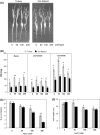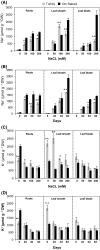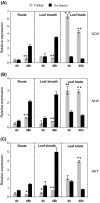Salt stress reveals differential physiological, biochemical and molecular responses in T. monococcum and T. durum wheat genotypes
- PMID: 28878491
- PMCID: PMC5567718
- DOI: 10.1007/s12298-017-0457-4
Salt stress reveals differential physiological, biochemical and molecular responses in T. monococcum and T. durum wheat genotypes
Abstract
Salt stress responses implicate a complex mechanism and differ from plant species to another. In this study, we analyzed the physiological, biochemical and molecular responses to salt stress of the diploid wheat (T. monococcum) and compared to the tetraploid wheat (T. durum). Our results showed that the diploid wheat cultivar (cv. Turkey) is relatively tolerant to different salt stress conditions than the tetraploid wheat cultivar (cv. Om Rabia3). This tolerance was manifested by significant germination, plant growth and uptake of water generating cell turgor and development. Moreover, total chlorophyll content was higher in the diploid wheat than that in the tetraploid wheat. The Na+ content in leaf blade of the cv. Om Rabia3 was significantly higher than that of the cv. Turkey, suggesting that the diploid cultivar accumulates less toxic sodium in the photosynthetic tissues. This mechanism could be explained by the recirculation of the toxic ions Na+ into the xylem sap by SOS1 protein, which coordinates with HKT-like proteins to reduce the accumulation of Na+ ions in leaf blade. Interestingly, the expression of the three genes SOS1, HKT and NHX was enhanced under salinity especially in leaf blade of the cv. Turkey. Moreover, this wheat cultivar induced the antioxidative enzymes CAT and SOD activity more efficiently than the other cultivar.
Keywords: Antioxidant enzyme; Diploid wheat; Salt stress; Sodium transport; Tetraploid wheat.
Conflict of interest statement
The authors declare that they have no conflict of interest.
Figures








References
-
- Ben Amor N, Ben Hamed K, Debez A, Grignon C, Abdelly C. Physiological and antioxidant responses of the perennial halophyte Crithmum maritimum to salinity. Plant Sci. 2005;168:889–899. doi: 10.1016/j.plantsci.2004.11.002. - DOI
Publication types
LinkOut - more resources
Full Text Sources
Other Literature Sources
Miscellaneous
